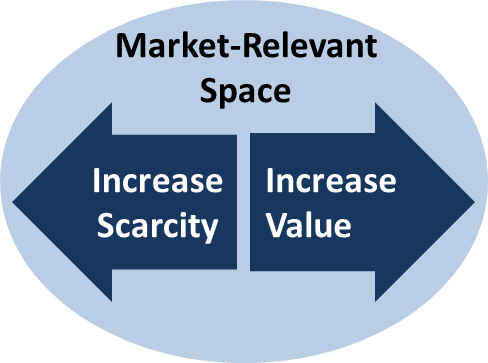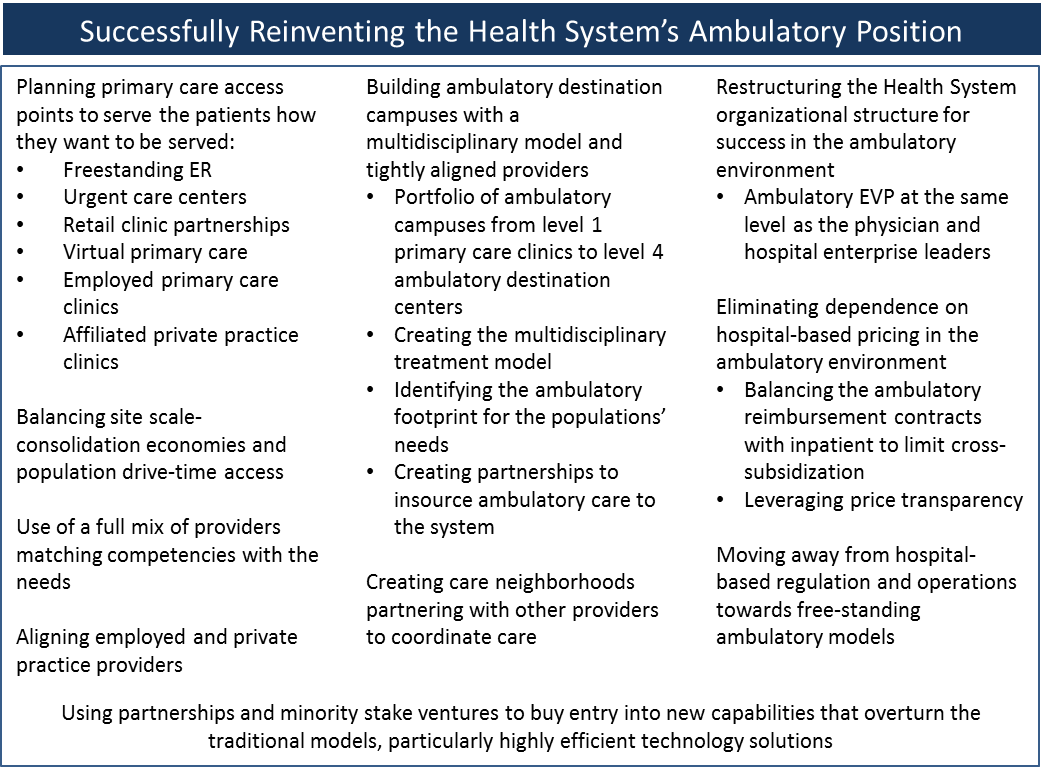3 approaches to market relevance
The following content is sponsored by Health System Advisors.
The U.S. health system depends on having strong hospital-based health systems. As the major component of the provider sector that maintains a patient-focused, nonprofit mission, the health systems fill a vital role for patients at their most vulnerable time: when they are the sickest. However, the financial system that has supported the hospital-based health systems is rapidly changing, and more agile non-traditional providers are rapidly moving into the hospital business. Consider how rapidly the following is happening:
- Insurers are moving to manage care by economically partnering with physicians
- Employers are using technology firms or alternative delivery models combined with now 44 percent (up from 27 percent in 2013) considering narrowed networks to lower costs
- Retailers are again growing healthcare clinics and looking for ways to use their large data sets to predict lifestyle habits that lead to disease
- Technology and communications vendors are providing virtual substitutes for traditional clinics, and organizations such as Apple and IBM are working to help patients manage their health information
- Private equity firms are aggregating delivery networks to arbitrage the shift from fee-for-service to risk-based reimbursement
The rapid increase of non-traditional competitors in the hospital delivery space suggests hospital-based health systems have a growing market relevance challenge. In our work with health systems around the country, we have seen first-hand how quickly health systems decline as they lose market relevance. With the rise of non-traditional competitors, health systems with declining market relevance often have an impossible time cutting price, improving quality and streamlining operations fast enough to remain solvent. In some cases pundits will profess the decline of weaker hospital-based health systems is a good thing. We, however, believe the health systems provide a vital role for individuals when they are sick and vulnerable that cannot be replaced by for-profit organizations seeking to profit from arbitrage opportunities in individual market segments. As such, the struggles weak hospital-based health systems are having today may be a leading indicator and a wake-up call for all health systems to evaluate and actively seek ways to improve their market relevance.
Strategies to build market relevance
Market relevance: The unique ability to satisfy the customers' needs.
We believe there are two major approaches to expand the market space in which the health system is relevant: 
1. Increase scarcity of the service by reducing the availability; or
2. Increase the value of the product or service to the customer by improving cost, quality or service.
The approaches are not mutually exclusive; however, the preferred approach chosen by the organization says a lot about the organizations mission.
1. Increase scarcity
Healthcare organizations grow market relevance by reducing the availability through mergers and acquisitions and rationalization of services within a market. This approach to create relevance is one of seeking leverage over the other market players and the customers. If both organizations in a two-hospital town merge to create one hospital, the new organization has increased market relevance and commands typically higher prices for their services — there is not an alternative for the consumer to pick and choose between.
While there are other reasons for merging, particularly reduced cost of capital, sharing overhead, etc., the "reduced availability approach" is helping to drive ever larger scale in the hospital-based health systems today. Moreover, it is one that hospitals and health systems fundamentally understand, as it is similar to managing operational capacity within hospitals. To the extent there is competition between hospitals and health systems (including physician groups) in a market or region, the strategy to reduce availability can be highly effective. Today there is an increasing potential to play one hospital or health system off another for better pricing, service or some other value characteristic. Being the must-have network combats this commoditization.
However, over the past few years there has been a rise of non-traditional substitutes to the health systems' models. Outlined above, these new entrants into the provider game are nowhere close to making the health system obsolute, but do present a challenge to the scarcity strategy. By virtue of the new entrants motivation (i.e., profit), these non-traditional competitors tend to siphon off the most profitable segments of the population. As a result, while it only represents a small fraction of the total customer base for the health system, that small percentage may contribute to the bottom line at seven to twelve times the average.
Health systems thus are wise to focus on the other way to grow market relevance: improve the value proposition.
2. Increase value
The healthcare value proposition has been presented as some form of cost, quality and service. In practice it is often not that simple. In fact, our research has shown organizations face a choice in how they improve their value equation; success usually requires the organization to be expert in one of the three areas.
Low-cost market leader
To remain relevant, the health system can run a more efficient model and be the overall low cost leader. This approach appears to be the required strategy for success under an ACO or population health reimbursement model. Through bringing together all the components of care, systems can rationalize out the high-cost elements. Of course most of these high-cost elements are sitting in the hospitals of the health system that is trying to profit from this strategy! Moreover, once the costs are out, the organization must go further next year as others will continue to try and compete for the volume at lower and lower prices until everyone has reached the marginal variable cost for each unit. In a high-fixed cost industry such as the hospital-based health systems, attempting a low-cost market strategy without a fundamental, sustainable cost competitive advantage is a race to the bottom.
High-quality market leader
The health system can run a higher-quality model. This approach depends on the ability to improve quality, accurately measure the improvement, and communicate that improvement to the market in convincing manner. For the sickest of the sick, this is often easier than for the majority of the patients in the health system's hospitals. Most processes, procedures and interventions simply do not have dramatically different enough outcomes for the public to be able to understand the difference. Moreover, quality outcome is often judged differently by the clinicians and the patient. Consider two patients that have had a major complex surgery where both survive without major infection, but one was in the hospital for fourteen days and lost twelve percent of their body weight while the other was in the hospital for five days and only lost five percent of their body weight and was able to resume normal activity without pain within a month.
Best-service market leader
As the two examples above illustrate, cost and quality are difficult roads to pursue without fully embracing the strategy in a no-return manner. Service is much more incremental and thus often the focus of many health systems. Many health systems have quickly garnered share through providing better service to physicians, or more convenient options for patients. The service tactics of the past, however, need to be updated for today's well-connected patients. For instance, the commercial populations upon which every health system heavily depends for its financial viability now has immediate access, through an iPhone app, to wait times, crowdsourced price lists or clinic ratings. As a result, health systems are rapidly losing the opacity of healthcare operations. Moreover, tech firms like Zipnosis and alternative delivery models like MD Live are teaming with communications and insurance giants to change how we view access to basic primary care, while retail giants Walgreens and CVS contemplate using buying habits to predict a person's lifestyle choices and future disease load, an important consideration if they want to move into population health. The patient demands for convenience continue to increase, and when told they can't have it their way, will find alternatives. Just in the field of primary care, urgent care, retail and virtual primary care are all growing at many multiples of the traditional scheduled primary care clinics.
What this means for your health system
As new players enter the provider space traditionally occupied by hospitals or work to drive health system pricing down, there are several key questions that can shed light on the avenues health systems can strengthen their market relevance.
- Are the new entrants truly organizing the patient care delivery or simply a cog in the gear?
- Can the alternatives care for patients across their lives or only in the here and now?
- Do the new players connect with patients such that they will turn to these alternatives when the patient feels sick and truly vulnerable?
To build market relevance, health systems must reinvent themselves without losing their core strengths of care organization, long-term relationships and community trust. Where reinvention is needed is where the informed consumer demands have shifted, technology has created viable substitutes, and accepted reimbursement models shift towards pricing transparency. The areas at the center of this tripartite are the primary care patient relationship and ambulatory care delivery models.
Any health system not actively engaged in successfully reinventing its ambulatory care positions is at risk of having new competitors dilute its long-standing market relevant position.



